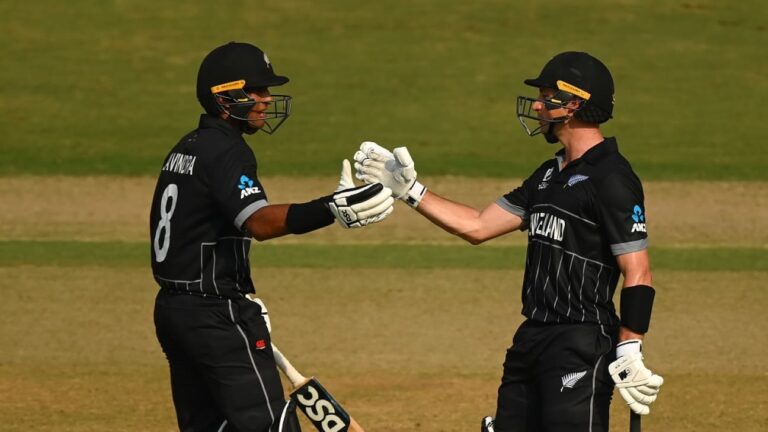Returning Kane Williamson and Tim Southee pose selection questions after strong start to tournament
firdose moonda

McClenaghan: “Ravindra could bat at No. 4 if Williamson returns”
Wasim Jaffer also expects Ravindra to maintain his place.
After the emotions were released in their opening World Cup victory over England, the team that robbed them of the trophy four years ago, New Zealand carried on in an almost surgical style against the Netherlands. Runs were scored, wickets and catches (mostly) taken, two points secured, NRR increased, and most importantly, selection questions answered. The biggest takeaway from this victory was the final match.
New Zealand went into the tournament with only 12 of their 15 players available for the first leg, with Kane Williamson and Tim Southee recovering from serious injuries and Lockie Ferguson suffering from back stiffness. . All 15 players should be in place by Friday’s next game, and their performance against the Netherlands will help decide who to select.
Let’s start with the obvious. Once captain Williamson is ready for competitive cricket, he will immediately return to number three. Typically, Devon Conway, Will Young, and Rachin Ravindra are the only two players left with room. All three have performed well in this tournament, with Young being the slowest to do so. He returned from a second-ball duck against England to score his third and sixth half-century this year, making a strong case for his continued role as an opener.
Scoring was important, but how they were scored may be more important in the end. Young’s first sign of aggression came in the fourth over when he grabbed two fours from Ryan Klein to put New Zealand ahead, but the hallmark of this innings was a spin takedown. His first six was a glorious elbow-high loft over Aryan Dutt, who was playing off for a long time. He then took a similar shot from Colin Ackerman. In total, Young got more than half of the runs (39 runs) off his 38 spin balls, and did it with good timing. New Zealand’s next two games are in spin-heavy Chennai against spin-heavy sides Bangladesh and Afghanistan, and Young is in form befitting his spot.
This means that when Williamson returns, New Zealand will have to make some changes to the composition of their line-up if they want to maintain the form of their current opening pair and Ravindra. The most likely solution is to leave Mark Chapman, who won next season’s Appreciation Award against England (he neither batted nor pitched) and scored 5 runs against Holland, on the bench and ask Ravindra to bat at number six. That’s probably true. spot. The alternative would be to let Ravindra bat at No. 4 and have the other players move down one spot. According to ESPNcricinfo expert Mitchell McClenaghan, Chapman is most likely to leave anyway.
The absence of Chapman and James Neesham, who replaced Ferguson against the Netherlands, means Mitchell Santner’s lower-order runs will carry a significant weight. Santner, who batted at number eight for Hyderabad, played a cameo role in the difference between New Zealand’s scores of 285 and 320. Bas de Lied lost his composure and Santner opted for a slower ball, resulting in 18 runs being conceded in the final over. While it was just a welcome addition in this game, contributions like this could be very important in future contests.
Matt Henry played alongside Santner in the final stages of the inning and had 10 four-balls. This should be a footnote, but it strengthens his case as New Zealand assess the composition of their attack. A difficult decision will then be made between Tim Southee, Henry, Ferguson and Trent Boult. No team cares about having problems like this aplenty, but New Zealand need to find a way to solve them.
As it stands, Henry is a force to be reckoned with with six wickets in his first two matches, but it’s not just the numbers that are working in his favor. He took wickets with the new ball and the old ball, constantly troubling the batsmen in the channels, and found an edge. In the past two years, Henry has taken 38 wickets at an average of 25.18, and McClenahan said he would choose Henry over Southee even if Southee was healthy.
For Ferguson, who was recovering for this game, that will likely mean more mileage. He bowled eight overs, conceding four runs in one over, and showed off his variations, but never reached a speed above 145 kmph. That was what New Zealand needed from him in this tournament. Ferguson may have been cautious coming back from injury, but if he isn’t going to provide out-and-out pace, Southie could get some game time.
“Here are the options – next match against Bangladesh, do you want to win three in a row? He has bowled very well against Bangladesh in the past – troubled opponents with his speed, but if in a situation like this, his speed is Unless,’ he might not be that worried,” McClenahan said. “I also have to think about whether I want to face Tim Southee in a match. Will it be the next match against Bangladesh?”
Whichever direction Boult, Henry, and Ferguson, Southee and Neesham go in, New Zealand have the best quality attacking force in the tournament and are in pretty good shape despite still being early in the event. are piling up. McClenahan was a little concerned that their intensity dipped a bit, especially as they gave up five chances from the field, but none of that was a huge cost. Even though New Zealand were going through a phase, they still got everything they needed from this game, including a little test with the ball, to prepare them for the games ahead.
Firdose Moonda is ESPNcricinfo’s South Africa and women’s cricket correspondent
